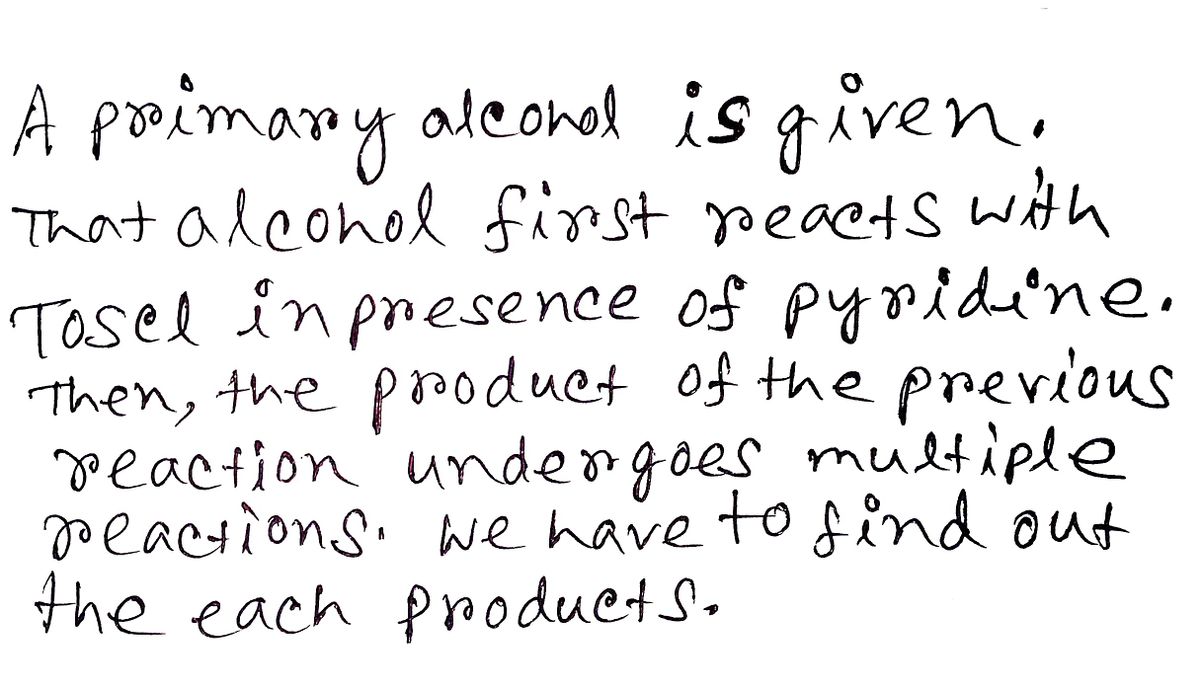c) Show the product formed at each of the three steps that connects starting material to the end target. Attack it from both ends. Deuterium (D) is just an isotope of hydrogen (H). HO H (primary alcohol) TosCl pyridine D HC C: H CH₂CH=NOH H₂NOH (H₂SO4) -H₂O HB 2 2. H₂O2, NaOH
c) Show the product formed at each of the three steps that connects starting material to the end target. Attack it from both ends. Deuterium (D) is just an isotope of hydrogen (H). HO H (primary alcohol) TosCl pyridine D HC C: H CH₂CH=NOH H₂NOH (H₂SO4) -H₂O HB 2 2. H₂O2, NaOH
Chemistry
10th Edition
ISBN:9781305957404
Author:Steven S. Zumdahl, Susan A. Zumdahl, Donald J. DeCoste
Publisher:Steven S. Zumdahl, Susan A. Zumdahl, Donald J. DeCoste
Chapter1: Chemical Foundations
Section: Chapter Questions
Problem 1RQ: Define and explain the differences between the following terms. a. law and theory b. theory and...
Related questions
Question
Predict the product.

Transcribed Image Text:To understand the synthesis pathway, refer to the following steps and reactions:
1. **Primary Alcohol Transformation:**
- The starting material is a primary alcohol with the structure depicted as HO-CH₂-CHD.
- This compound undergoes a reaction with tosyl chloride (TsCl) in the presence of pyridine, resulting in the formation of a tosylate intermediate. This step replaces the hydroxyl group (OH) with a tosyl (OTs) group.
2. **Alkyne Formation:**
- The resulting tosylate then undergoes a nucleophilic substitution with an acetylide ion (HC≡C⁻), forming an alkyne via an SN2 mechanism. The deuterium (D) is retained in the structure.
3. **Final Product Formation:**
- The alkyne is subsequently transformed via hydroboration-oxidation reactions:
1. The alkyne reacts with a borane (BH₃ or a similar reagent), followed by hydrogen peroxide (H₂O₂) and sodium hydroxide (NaOH) to afford an anti-Markovnikov addition product, an alcohol.
2. The reaction sequence yields a structure where the position of the hydroxyl group is determined by the regioselectivity of the reagents.
Overall, the sequence illustrates the transformation of a primary alcohol into a specified final product through sequential substitution, elimination, and addition reactions, explicitly noting the retention and position of deuterium atoms throughout the process.
Expert Solution
Step 1: Introduction to reaction of alcohol

Step by step
Solved in 3 steps with 3 images

Knowledge Booster
Learn more about
Need a deep-dive on the concept behind this application? Look no further. Learn more about this topic, chemistry and related others by exploring similar questions and additional content below.Recommended textbooks for you

Chemistry
Chemistry
ISBN:
9781305957404
Author:
Steven S. Zumdahl, Susan A. Zumdahl, Donald J. DeCoste
Publisher:
Cengage Learning

Chemistry
Chemistry
ISBN:
9781259911156
Author:
Raymond Chang Dr., Jason Overby Professor
Publisher:
McGraw-Hill Education

Principles of Instrumental Analysis
Chemistry
ISBN:
9781305577213
Author:
Douglas A. Skoog, F. James Holler, Stanley R. Crouch
Publisher:
Cengage Learning

Chemistry
Chemistry
ISBN:
9781305957404
Author:
Steven S. Zumdahl, Susan A. Zumdahl, Donald J. DeCoste
Publisher:
Cengage Learning

Chemistry
Chemistry
ISBN:
9781259911156
Author:
Raymond Chang Dr., Jason Overby Professor
Publisher:
McGraw-Hill Education

Principles of Instrumental Analysis
Chemistry
ISBN:
9781305577213
Author:
Douglas A. Skoog, F. James Holler, Stanley R. Crouch
Publisher:
Cengage Learning

Organic Chemistry
Chemistry
ISBN:
9780078021558
Author:
Janice Gorzynski Smith Dr.
Publisher:
McGraw-Hill Education

Chemistry: Principles and Reactions
Chemistry
ISBN:
9781305079373
Author:
William L. Masterton, Cecile N. Hurley
Publisher:
Cengage Learning

Elementary Principles of Chemical Processes, Bind…
Chemistry
ISBN:
9781118431221
Author:
Richard M. Felder, Ronald W. Rousseau, Lisa G. Bullard
Publisher:
WILEY